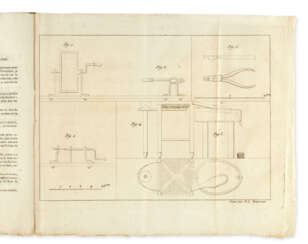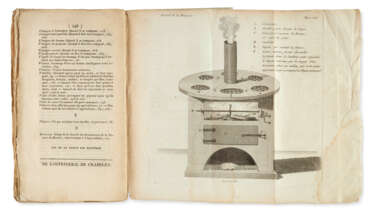taille-douce

Georges Rouault was a French painter, printmaker and ceramicist whose profound works combined art and spirituality, making him a key figure in the contemporary art world. Born into a modest family in Paris during the turbulent times of the Paris Commune, Rouault's early exposure to art came through his grandfather's collection of lithographs by Honoré Daumier. His initial apprenticeship in a glazier's workshop had a profound influence on his artistic style, especially his work with stained glass, which later became a hallmark of his painting technique.
Rouault's career took a significant turn under the tutelage of Symbolist painter Gustave Moreau, who introduced him to avant-garde circles, leading Rouault into the Fauvist movement alongside Henri Matisse. However, Rouault's unique approach was characterized by a more instinctive and spontaneous style that was deeply influenced by Vincent van Gogh and which eventually led him to Expressionism. His works from this period, dealing with subjects such as courts, clowns, and prostitutes, served as a form of moral and social criticism, motivated by his deep Christian faith and concern for human nature. This period marked a significant evolution in Rouault's style; his paintings reflect a mixture of religious iconography and human suffering, demonstrating his mastery of conveying deeply emotional and spiritual stories.
One of Rouault's most notable contributions to art was his involvement in the scenography for Sergei Diaghilev's ballet The Prodigal Son and his famous series of paintings and prints such as Miserere. His later works are renowned for their explosive use of color and texture, highlighting his mastery of expressing the spiritual harmony and beauty of nature. The end of Rouault's career was marked by a gesture of humility and dedication to his craft: he destroyed a significant number of his unfinished works, feeling that he could not complete them to his satisfaction.
Rouault's legacy has been preserved through his impressive works in renowned museums and galleries around the world. His art continues to inspire and resonate with collectors, experts and lovers of art and antiques, serving as a testament to his enduring influence on the art world.
For those deeply interested in exploring the life and work of Georges Rouault, it is important to stay abreast of new discoveries, sales, and auction events related to his art. We encourage you to subscribe to updates so that you don't miss out on the opportunity to engage with the legacy of this remarkable artist. This subscription will be your gateway to the world of Georges Rouault, offering exclusive insights into his contribution to contemporary art.


Edward Steichen was a Luxembourgish American photographer, painter, and curator, renowned as one of the most prolific and influential figures in the history of photography.
Steichen was credited with transforming photography into an art form. His photographs appeared in Alfred Stieglitz's groundbreaking magazine Camera Work more often than anyone else during its publication run from 1903 to 1917. Stieglitz hailed him as "the greatest photographer that ever lived".


Pablo Ruiz Picasso, a Spanish artist renowned for his revolutionary contributions to the 20th-century art scene, is a figure that resonates profoundly with collectors and art experts. His unique blend of talents in painting, sculpture, printmaking, and ceramic art, infused with his time in France, positioned him as a pivotal character in modern art history.
Picasso's artistic journey was marked by distinct periods, each showcasing his evolving style and genius. His early years were characterized by the Blue Period (1901-1904), followed by the Rose Period (1904-1906), and then the African-influenced Period (1907-1909). Picasso's name is synonymous with Cubism, a movement he co-founded, which significantly altered artistic perspectives and methods. Works like "Les Demoiselles d'Avignon" (1907) and "Guernica" (1937) are emblematic of his cubist legacy, the latter being a poignant anti-war statement that remains influential.
His later years saw a return to more traditional styles, with neoclassical and surrealist influences becoming evident. Works from these phases reflect a deep engagement with mythological themes, as seen in "Faun with Stars" (1955), symbolizing his late-life romance with Jacqueline Roque, his second wife.
Picasso's prolific output and innovative spirit made him a legend in his own time, a status that only grew after his death. His works, housed in major museums and private collections worldwide, continue to captivate and inspire.
As a collector or expert in art and antiques, staying informed about Picasso's works, their auction events, and sales is essential. To stay updated on the latest developments and opportunities related to Pablo Picasso, sign up for our specialized updates. Rest assured, this subscription will focus solely on new product sales and auction events pertaining to Picasso's art, ensuring that you receive only the most relevant and valuable information.

Paul Bonet, birth name Paul Joseph Ghislain Bonet, is a French bookbinder and bookbinding designer, Knight of the Legion of Honor.
Trained to make fashionable wooden mannequins, Paul Bonet worked in the fashion industry for several years and did not turn to bookbinding until 1920. His bright, colorful designs and prolific work made him famous. His first bindings were exhibited in 1925 at the Gallière Museum, then at the French Book Arts Exhibition, the Salon d'Automne and the Salon des Artistes Décoratifs, and his talent was recognized.
His decoration was particularly innovative. One of the great masters of French bookbinding, Paul Bonet became famous in the 1930s and 1940s for one of his signature patterns, "sunbeams." These patterns consist of many small lines with gold trim, carefully planned and giving the optical illusion of spatial depth.



.jpg)
René Magritte, a Belgian artist, was renowned for his significant contributions to the Surrealist movement. His art, known for merging ordinary objects with bizarre, dream-like contexts, captivated the art world. Born on November 21, 1898, in Lessines, Belgium, Magritte's early artistic pursuits were impressionistic, transitioning through Cubism and Futurism influenced by artists like Jean Metzinger. However, his encounter with Giorgio de Chirico's work in 1922 steered him towards Surrealism.
Magritte's career was marked by various phases, each showcasing his evolving style and thematic focus. His initial foray into Surrealism began in 1926 with "The Lost Jockey" and was further solidified during his time in Paris, where he mingled with other prominent Surrealists like André Breton. Despite facing initial criticism and financial challenges, Magritte's unique blend of familiar imagery in unfamiliar contexts, like in "The Empire of Light" and "Time Transfixed," earned him acclaim.
Magritte's distinct visual language, characterized by recurring motifs like bowler hats and apples, and his exploration of reality and illusion, remain influential. His works are displayed in major galleries worldwide, continuing to inspire and intrigue art collectors and enthusiasts.
For collectors and experts in art and antiques, staying informed about Magritte's works and related auction events is crucial. Signing up for updates ensures you're alerted to new sales and events focusing on René Magritte's art, offering unique opportunities to acquire or learn more about his remarkable creations. This subscription will exclusively cover new product sales and auction events related to Magritte, keeping you updated on the most relevant information in the art world.


Christiaan Huygens van Zeelhem was a Dutch mechanic, physicist, mathematician, inventor and astronomer who formulated the wave theory of light.
An admirer of Descartes, Huygens preferred to conduct new experiments himself to observe and formulate laws. In physics, he contributed to the development of the crucial Huygens-Fresnel principle, which applies to wave propagation. He also extensively investigated free fall. He experimentally proved the law of conservation of momentum. He derived the law of centrifugal force for uniform circular motion.
He also invented the pendulum clock, discovered centrifugal force and the true shape of Saturn's rings as well as its moon Titan. Huygens is considered the first theoretical physicist to use formulas in physics and one of the founders of theoretical mechanics and probability theory.


Littret de Montigny, full name Claude-Antoine Littret de Montigny, was a French painter, engraver, and publisher.
Among de Montigny's other works, his album in which he depicted a variety of uniforms and flags of the French army under Louis XV, accompanied by a brief description, stands out, providing a unique insight into the French army of the time.




















![[HOOGHE, Romeyn de (1645-1708)] -- CHERTABLON La Manière de ...](/assets/image/picture_1077776/6f41f/bc05724bbc283fa571591ce6e9d6a9541604358000jpg__fix_374_244.jpeg)
![[HOOGHE, Romeyn de (1645-1708)] -- CHERTABLON La Manière de ...](https://veryimportantlot.com/assets/image/picture_1077776/6f41f/bc05724bbc283fa571591ce6e9d6a9541604358000jpg__fix_374_244.jpeg)












![[LA SALE, Antoine de (circa 1386-1462)] et Romeyn de HOOGHE (1645-1708)](/assets/image/picture_1431275/fc43b/bea05450cbb56a70d623ab12e8cdc0781620043200jpg__fix_374_244.jpeg)
![[LA SALE, Antoine de (circa 1386-1462)] et Romeyn de HOOGHE (1645-1708)](https://veryimportantlot.com/assets/image/picture_1431275/fc43b/bea05450cbb56a70d623ab12e8cdc0781620043200jpg__fix_374_244.jpeg)























![[ALMANACH DU COMESTIBLE].](/assets/image/picture_2734614/8fff8/857e684148705951c4c2cded7503ceca1679526000jpg__fix_374_244.jpeg)
![[ALMANACH DU COMESTIBLE].](https://veryimportantlot.com/assets/image/picture_2734614/8fff8/857e684148705951c4c2cded7503ceca1679526000jpg__fix_374_244.jpeg)


![[EPULUM PARASITICUM].](/assets/image/picture_2734773/97452/b1d668c59def8f1336992d617c392eeb1679526000jpg__fix_374_244.jpeg)
![[EPULUM PARASITICUM].](https://veryimportantlot.com/assets/image/picture_2734773/97452/b1d668c59def8f1336992d617c392eeb1679526000jpg__fix_374_244.jpeg)
![[MENON, Joseph (ca. 1700-1771)].](/assets/image/picture_2734805/597a8/4b994329de3eb2b67a97bf66bd4ece571679526000jpg__fix_374_244.jpeg)
![[MENON, Joseph (ca. 1700-1771)].](https://veryimportantlot.com/assets/image/picture_2734805/597a8/4b994329de3eb2b67a97bf66bd4ece571679526000jpg__fix_374_244.jpeg)




